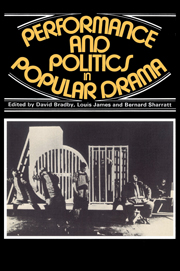 Performance and Politics in Popular Drama
Performance and Politics in Popular Drama Book contents
- Frontmatter
- Contents
- List of contributors
- Preface
- Acknowledgements
- PART ONE Spectacle, performance and audience in nineteenth-century theatre
- Introduction
- Was Jerrold's Black Ey'd Susan more popular than Wordsworth's Lucy?
- Word and image in Pixérécourt's melodramas: the dramaturgy of the strip-cartoon
- Joseph Bouchardy: a melodramatist and his public
- The music of melodrama
- Popular theatre in Victorian Birmingham
- Water drama
- Equestrian drama and the circus
- Theatre of war: the Crimea on the London stage 1854–5
- Popular drama and the mummers' play
- PART TWO Politics and performance in twentieth-century drama and film
- PART THREE Problems and prospects
- Appendix: Tempo, Tempo
- Select bibliography
- General index
- Index of titles of plays, films, sketches
- Index of theatres, theatre companies and groups
Joseph Bouchardy: a melodramatist and his public
Published online by Cambridge University Press: 08 March 2010
- Frontmatter
- Contents
- List of contributors
- Preface
- Acknowledgements
- PART ONE Spectacle, performance and audience in nineteenth-century theatre
- Introduction
- Was Jerrold's Black Ey'd Susan more popular than Wordsworth's Lucy?
- Word and image in Pixérécourt's melodramas: the dramaturgy of the strip-cartoon
- Joseph Bouchardy: a melodramatist and his public
- The music of melodrama
- Popular theatre in Victorian Birmingham
- Water drama
- Equestrian drama and the circus
- Theatre of war: the Crimea on the London stage 1854–5
- Popular drama and the mummers' play
- PART TWO Politics and performance in twentieth-century drama and film
- PART THREE Problems and prospects
- Appendix: Tempo, Tempo
- Select bibliography
- General index
- Index of titles of plays, films, sketches
- Index of theatres, theatre companies and groups
Summary
Je suis heureux de terminer Phistoire de 1* Ambigu en signalant le succès le plus productif qu'ait obtenu ce théâtre. M.Joseph Bouchardy est la providence des directeurs; il les enrichit tous, il fait maintenant avec Lazare le pâtre des recettes inouïes, miraculeuses, des recettes aussi extraordinaires que celles du Sonneur de Saint-Paul qui a procuré à la Gaîté plus de 200,000 francs de bénéfices.
Joseph Bouchardy, 1810–70, ‘le grand impresario des terreurs du boulevard’, was the author of a score of drames and a successor to Pixérécourt, whose plays he read avidly in his youth.
Bouchardy's plays cannot be examined without a look at the audiences for which they were designed. All but a handful were staged at either the Ambigu or the Gaîté. These two theatres, classified by Napoleon as places where melodramas might be performed, had originally been situated next to one another on the Boulevard du Temple. After a fire in 1827 the new Ambigu was reconstructed on the Boulevard Saint Martin, almost next door to the Theatre de la Porte Saint Martin. The Gaîté was burnt down in 1835, and the new theatre which rose again on the same site, had, like the Ambigu, an enlarged seating capacity. These new buildings were being erected at a time when the boulevards were becoming more fashionable places of resort and losing much of their earlier fairground appearance. The bourgeois take-over of the theatre of the boulevards is best symbolised by the persistent popularity and the ideological values of the plays of Eugène Scribe at the Gymnase.
- Type
- Chapter
- Information
- Performance and Politics in Popular DramaAspects of Popular Entertainment in Theatre, Film and Television, 1800–1976, pp. 33 - 48Publisher: Cambridge University PressPrint publication year: 1980
